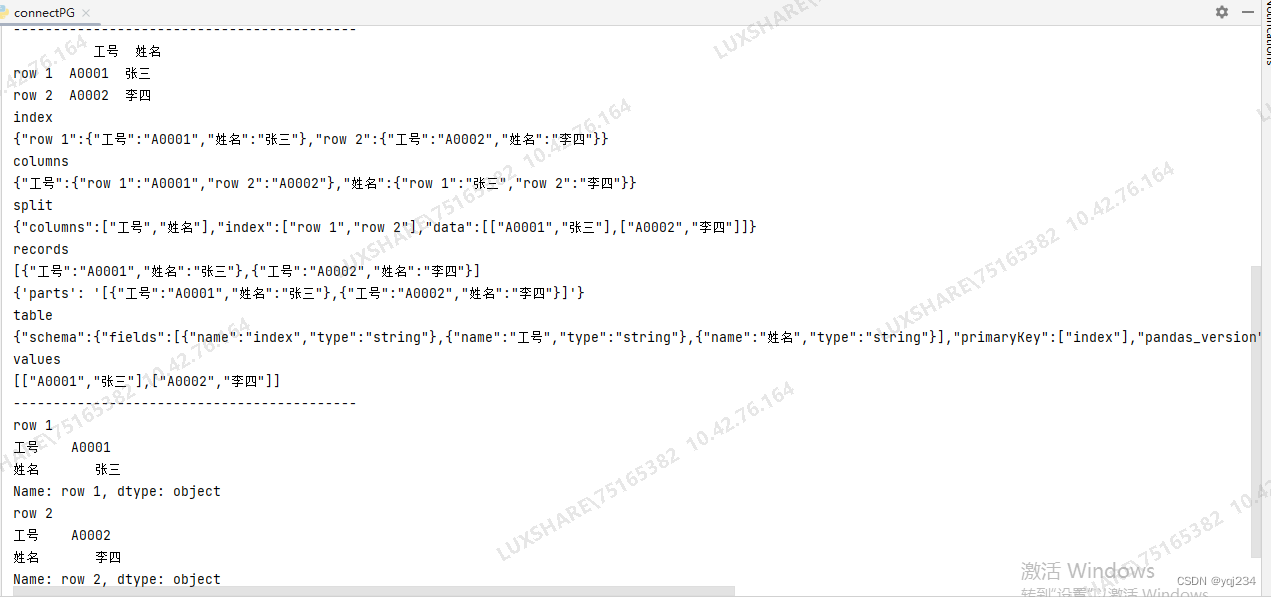网络上有好多的教程,讲得不太清楚和明白,我用实际的例子说明了一下内容,附档代码,方便理解和使用
DataFrame.to_json(path_or_buf=None, orient=None, date_format=None, double_precision=10, force_ascii=True, date_unit='ms', default_handler=None, lines=False, compression='infer', index=True, indent=None) [source]
将对象转换为JSON字符串。
注意:NaN和None将被转换为null, datetime对象将被转换为UNIX时间戳。
| 参数: | path_or_buf : 文件路径或对象。如果未指定,则结果以字符串形式返回。 orient : 预期的JSON字符串格式的指示。 1) Series: 默认值为 允许的值为: 2) DataFrame: 默认为 允许的值为:
3) JSON字符串格式:
描述数据,其中数据成分类似于 在版本0.20.0中更改。 date_format : 日期转换的类型。
对于 对于所有其他东方,默认值为 double_precision : 在对浮点值进行编码时要使用的小数位数。 force_ascii : 强制将字符串编码为 date_unit : 要编码的时间单位,控制时间戳和ISO8601精度。
default_handler :callable, 默认为 如果对象不能转换为适合JSON的格式,则调用。 应该接收一个参数,该参数是要转换的对象并返回一个可序列化对象。 lines : 如果 如果不正确的 compression : 表示要在输出文件中使用的压缩的字符串, 仅在第一个参数是文件名时使用。默认情况下, 压缩是从文件名推断出来的。 在0.24.0版本中更改:增加了 index : 是否在JSON字符串中包括索引值。 仅当 才支持不包括index( 0.23.0版中的新功能。 indent : 用于缩进每条记录的空白长度。 1.0.0版的新功能。。 |
| 返回值: |
如果 则将生成的 否则返回 |
Notes
indent=0的行为与stdlib不同,stdlib不会缩进输出,但会插入新行。目前,在panda中,indent=0和默认的indent=None是等价的,不过在将来的版本中可能会更改。
df = pd.DataFrame( [["A0001", "张三"], ["A0002", "李四"]], index=["row 1", "row 2"],columns=["工号", "姓名"] )
print('-------------------------------------------')
print(df)
print('index')
print(df.to_json(orient='index',force_ascii=False))
print('columns')
print(df.to_json(orient='columns',force_ascii=False))
print('split')
print(df.to_json(orient='split',force_ascii=False))
print('records')
print(df.to_json(orient='records',force_ascii=False))
mydate={"parts":df.to_json(orient='records',force_ascii=False)}
print(mydate)
print('table')
print(df.to_json(orient='table',force_ascii=False))
print('values')
print(df.to_json(orient='values',force_ascii=False))
print('-------------------------------------------')
#遍历
for index, row in df.iterrows():
print(index)
print(row)输出内容,理解转化在json的内容的逻辑
-------------------------------------------
工号 姓名
row 1 A0001 张三
row 2 A0002 李四
index
{"row 1":{"工号":"A0001","姓名":"张三"},"row 2":{"工号":"A0002","姓名":"李四"}}
columns
{"工号":{"row 1":"A0001","row 2":"A0002"},"姓名":{"row 1":"张三","row 2":"李四"}}
split
{"columns":["工号","姓名"],"index":["row 1","row 2"],"data":[["A0001","张三"],["A0002","李四"]]}
records
[{"工号":"A0001","姓名":"张三"},{"工号":"A0002","姓名":"李四"}]
{'parts': '[{"工号":"A0001","姓名":"张三"},{"工号":"A0002","姓名":"李四"}]'}
table
{"schema":{"fields":[{"name":"index","type":"string"},{"name":"工号","type":"string"},{"name":"姓名","type":"string"}],"primaryKey":["index"],"pandas_version":"1.4.0"},"data":[{"index":"row 1","工号":"A0001","姓名":"张三"},{"index":"row 2","工号":"A0002","姓名":"李四"}]}
values
[["A0001","张三"],["A0002","李四"]]
-------------------------------------------
row 1
工号 A0001
姓名 张三
Name: row 1, dtype: object
row 2
工号 A0002
姓名 李四
Name: row 2, dtype: object






















 2629
2629











 被折叠的 条评论
为什么被折叠?
被折叠的 条评论
为什么被折叠?








